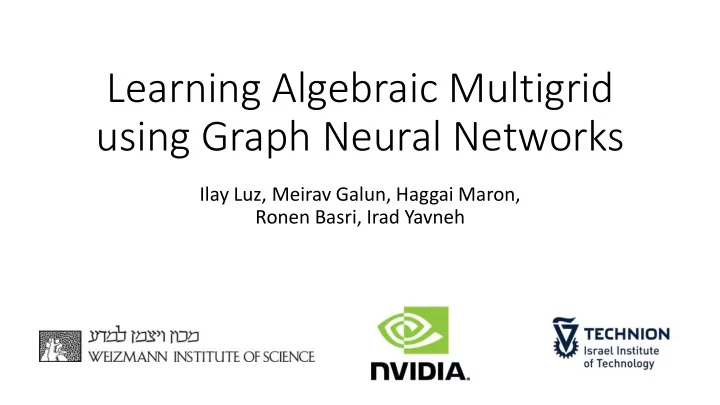

Learning Algebraic Multigrid using Graph Neural Networks Ilay Luz, Meirav Galun, Haggai Maron, Ronen Basri, Irad Yavneh
Goal: Large scale linear systems • Solve 𝐵𝑦 = 𝑐 • 𝐵 is huge, need 𝑃 𝑜 solution! • Some applications: 𝜖 2 𝑣 𝜖𝑦 2 + 𝜖 2 𝑣 • Discretization of PDEs 𝜖𝑧 2 = 𝑔 𝑦, 𝑧 • Sparse graph analysis
Efficient linear solvers • Decades of research on efficient iterative solvers for large- scale systems • We focus on Algebraic Multigrid (AMG) solvers • Can we use machine learning to improve AMG solvers? • Follow-up to Greenfeld et al. (2019) on Geometric Multigrid
What AMG does • AMG works by successively coarsening the system of equations, and solving on multiple scales • Prolongation operator 𝑄 that creates the hierarchy • We want to learn a mapping 𝑄 𝜄 𝐵 with fast convergence
Learning 𝑄 • Unsupervised loss function over distribution : min 𝜄 𝔽 𝐵~ 𝜍 𝑁 𝐵, 𝑄 𝜄 𝐵 • 𝜍 𝑁 𝐵, 𝑄 𝜄 𝐵 measures the convergence factor of the solver • 𝑄 𝜄 𝐵 is a NN mapping system 𝐵 to prolongation operator 𝑄
Graph neural network • Sparse matrices can be represented as graphs – we use a Graph Neural Network as the mapping 𝑄 𝜄 𝐵 5 6 2.7 −0.5 −0.5 0 −1.7 0 0 −0.5 7.7 −4.9 −0.6 0 0 −1.7 −0.5 −4.9 6.2 0 0 −0.8 0 4 1 0 −0.6 0 2.9 −0.6 0 −1.7 −1.7 0 0 −0.6 13.1 −10.8 0 0 0 −0.8 0 −10.8 11.6 0 0 −1.7 0 −1.7 0 0 3.4 7 2 3
Benefits of our approach • Unsupervised training – rely on algebraic properties • Generalization – learn general rules for wide class of problems • Efficient training – Fourier analysis reduces computational burden
Sample result; lower is better, ours is lower! Finite Element PDE
Outline • Overview of AMG • Learning objective • Graph neural network • Results
1 st ingredient of AMG: Relaxation • System of equations: 𝑏 𝑗1 𝑦 1 + 𝑏 𝑗2 𝑦 2 + ⋯ 𝑏 𝑗𝑜 𝑦 𝑜 = 𝑐 𝑗 1 • Rearrange: 𝑦 𝑗 = 𝑏 𝑗𝑗 𝑐 𝑗 − σ 𝑘≠𝑗 𝑏 𝑗𝑘 𝑦 𝑘 (0) • Start with an initial guess 𝑦 𝑗 (𝑙+1) = 1 (𝑙) • Iterate until convergence: 𝑦 𝑗 𝑏 𝑗𝑗 𝑐 𝑗 − σ 𝑘≠𝑗 𝑏 𝑗𝑘 𝑦 𝑘
Relaxation smooths the error • Since relaxation is a local procedure, its effect is to smooth out the error • How to accelerate relaxation by dealing with low-frequency errors?
2 nd ingredient of AMG: Coarsening • Smooth error, and then coarsen Relax Coarsen • Error is no longer smooth on coarse grid; relaxation is fast again!
Putting it all together Relaxation (smoothing) Smaller Error on original problem Error on original problem Restriction Prolongation Error approximated on coarsened problem
Learning objective
Prolongation operator • Focus of AMG is prolongation operator 𝑄 for defining scales and moving between them • 𝑄 needs to be sparse for efficiency, but also approximate well smooth errors
Learning 𝑄 • Quality can be quantified by estimating by how much the error is reduced each iteration: • 𝑓 (𝑙+1) = 𝑁 𝐵, 𝑄 𝑓 (𝑙) • 𝑁 𝐵, 𝑄 = 𝑇 𝐽 − 𝑄 𝑄 𝑈 𝐵𝑄 −1 𝑄 𝑈 𝐵 𝑇 • Asymptotically: ‖𝑓 (𝑙+1) ‖ ≈ 𝜍 𝑁 ‖𝑓 (𝑙) ‖ • Spectral radius: 𝜍 𝑁 = max 𝜇 1 , … , 𝜇 𝑜 • Our learning objective: min 𝜄 𝔽 𝐵~ 𝜍 𝑁 𝐵, 𝑄 𝜄 𝐵
Graph neural network
Representing 𝑄 𝜄 • Sparse matrix 𝐵 ∈ ℝ 𝑜×𝑜 to sparse matrix 𝑄 ∈ ℝ 𝑜×𝑜 𝑑 • Mapping should be efficient • Matrices can be represented as graphs with edge weights
Representing 𝑄 𝜄 1 4 6 1 0 0 1 0 .3 0.7 0 2 0.9 0 0.1 2.7 −0.5 −0.5 0 −1.7 0 0 3 −0.5 7.7 −4.9 −0.6 0 0 −1.7 0 1 0 −0.5 −4.9 6.2 0 0 −0.8 0 4 0 0.2 0.8 0 −0.6 0 2.9 −0.6 0 −1.7 5 −1.7 0 0 −0.6 13.1 −10.8 0 0 0 1 0 0 −0.8 0 −10.8 11.6 0 6 0 1 0 0 −1.7 0 −1.7 0 0 3.4 7 5 5 5 6 6 6 4 4 1 4 1 1 7 7 7 2 3 2 3 2 3 Sparsity Output 𝑄 Input 𝐵 pattern
GNN architecture • Message Passing architectures can handle any graph, and have 𝑃 𝑜 runtime 5 5 6 4 1 1 2 7 2 3 3 • Graph Nets framework from Battaglia et al. (2018) generalize many MP variants, handle edge features
Results
Spectral clustering • Bottleneck is an iterative eigenvector algorithm that uses a linear solver • Evaluate number of iterations required to reach convergence • Train network on dataset of small 2D clusters, test on various 2D and 3D distributions
Conclusion • Algebraic Multigrid is an effective 𝑷 𝒐 solver for a wide class of linear systems 𝐵𝑦 = 𝑐 • Main challenge in AMG is constructing prolongation operator 𝑸 , which controls how information is passed between grids • We use an 𝑃 𝑜 , edge-based GNN to learn a mapping 𝑄 𝜄 𝐵 , without supervision • GNN generalizes to larger problems, with different distributions of sparsity pattern and elements
Take home messages • In a well-developed field, might make sense to apply ML to a part of the algorithm • Graph neural networks can be an effective tool for learning sparse linear systems
Recommend
More recommend